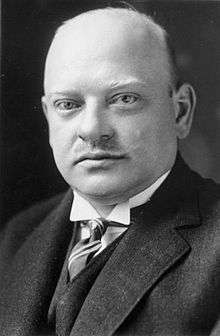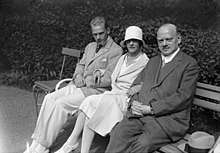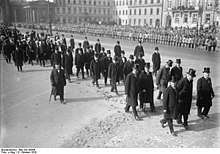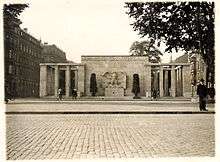Gustav Stresemann
Gustav Ernst Stresemann (![]()
Gustav Stresemann | |
|---|---|
 | |
| Chancellor of Germany (Weimar Republic) | |
| In office 13 August 1923 – 30 November 1923 | |
| President | Friedrich Ebert |
| Preceded by | Wilhelm Cuno |
| Succeeded by | Wilhelm Marx |
| Minister of Foreign Affairs | |
| In office 13 August 1923 – 3 October 1929 | |
| Chancellor | Himself Wilhelm Marx Hans Luther Hermann Müller |
| Preceded by | Hans von Rosenberg |
| Succeeded by | Julius Curtius |
| Personal details | |
| Born | 10 May 1878 Berlin, German Empire |
| Died | 3 October 1929 (aged 51) Berlin, Weimar Republic |
| Political party | National Liberal Party (1907–1918) German Democratic Party (1918) German People's Party (1918–1929) |
| Spouse(s) | Käte Kleefeld |
| Children | Wolfgang Hans-Joachim |
His most notable achievement was the reconciliation between Germany and France, for which he and Aristide Briand received the Nobel Peace Prize. During a period of political instability and fragile, short-lived governments, he was generally seen as the most influential cabinet member in most of the Weimar Republic's existence. During his political career, he represented three successive liberal parties; he was the dominant figure of the German People's Party during the Weimar Republic.
Early years
Stresemann was born on 10 May 1878 in 66 Köpenicker Straße in Southeast Berlin, the youngest of seven children. His father worked as a beer bottler and distributor, and also ran a small bar out of the family home, as well as renting rooms for extra money. The family was lower middle class, but relatively well-off for the neighbourhood, and had sufficient funds to provide Gustav with a high-quality education.[1] Stresemann was an excellent student, particularly excelling in German literature and poetry. At the age of 16, he joined the Andreas Gymnasium to study. His parents brought him to have an interest in books - He was especially passionate about history, with his teacher, Mr. Wolff, commenting that he had an "almost sickly taste in history". He took an interest in Napoleon and Johann Wolfgang von Goethe, whom he later wrote about in his work 1924: Goethe und Napoleon: ein Vortrag.[2] His mother, Mathilde, died in 1895. From December 1895, he wrote "Berlin letters" for the Dresdener Volks-Zeitung, often talking about politics and targeting Prussian conservatives. In an essay written when he left school, he noted that he would have enjoyed becoming a teacher, but he would only have been qualified to teach languages or the natural sciences, which were not his primary areas of interest.[3] Due to this, he enrolled in University.
In April 1897, Stresemann enrolled in the University of Berlin, where he was convinced by a businessman to study political economy instead of literature.[4] During his university years, Stresemann also became active in Burschenschaften movement of student fraternities, and became editor, in April 1898, of the Allgemeine Deutsche Universitäts-Zeitung, a newspaper run by Konrad Kuster, a leader in the liberal portion of the Burschenschaften. His editorials for the paper were often political, and dismissed most of the contemporary political parties as broken in one way or another.[5] In these early writings, he set out views that combined liberalism with strident nationalism, a combination that would dominate his views for the rest of his life.[6] In 1898, Stresemann left the University of Berlin, transferring to the University of Leipzig so that he could pursue a doctorate. He studied History, International Law, and took literature courses. Influenced by Dr. Martin Kriele, he also took courses in Economics. In March 1899, he stopped becoming an editor for the Allgemeine Deutsche Universitäts-Zeitung. He completed his studies in January 1901, submitting a thesis on the bottled beer industry in Berlin, which received a relatively high grade, but was a subject of mockery from colleagues.[7][8][9] Stresemann's doctoral supervisor was the economist Karl Bücher.[10]
In 1902 he founded the Saxon Manufacturers' Association. In 1903 he married Käte Kleefeld (1883–1970), daughter of a wealthy Jewish Berlin businessman, and the sister of Kurt von Kleefeld, the last person in Germany to be ennobled (in 1918). At that time he was also a member of Friedrich Naumann's National-Social Association. In 1906 he was elected to the Dresden town council. Though he had initially worked in trade associations, Stresemann soon became a leader of the National Liberal Party in Saxony. In 1907, he was elected to the Reichstag, where he soon became a close associate of party chairman Ernst Bassermann. However, his support of expanded social-welfare programs did not sit well with some of the party's more conservative members, and he lost his post in the party's executive committee in 1912. Later that year he lost both his Reichstag and town council seats. He returned to business and founded the German-American Economic Association. In 1914 he returned to the Reichstag. He was exempted from war service due to poor health. With Bassermann kept away from the Reichstag by either illness or military service, Stresemann soon became the National Liberals' de facto leader. After Bassermann's death in 1917, Stresemann succeeded him as the party leader.
The evolution of his political ideas appears somewhat erratic. Initially, in the German Empire, Stresemann was associated with the left wing of the National Liberals. During World War I, he gradually moved to the right, expressing his support of the monarchy and Germany's expansionist goals. He was a vocal proponent of unrestricted submarine warfare. However, he still favoured an expansion of the social welfare programme, and also supported an end to the restrictive Prussian franchise.
When the Allies' peace terms became known, including a crushing burden of paying reparations for the war, Constantin Fehrenbach denounced them and claimed "the will to break the chains of slavery would be implanted" into a generation of Germans. Stresemann said of this speech: "He was inspired in that hour by God to say what was felt by the German people. His words, spoken under Fichte's portrait, the final words of which merged into “Deutschland, Deutschland über alles”, made it an unforgettably solemn hour. There was in that sense a kind of uplifting grandeur. The impression left on all was tremendous".[11]
Stresemann briefly joined the German Democratic Party after the war, but was expelled for his association with the right wing. He then gathered the main body of the old National Liberal Party—including most of its centre and right factions—into the German People's Party (German: Deutsche Volkspartei, DVP), with himself as chairman. Most of its support came from middle class and upper class Protestants. The DVP platform promoted Christian family values, secular education, lower tariffs, opposition to welfare spending and agrarian subsidies and hostility to "Marxism" (that is, the Communists, and also the Social Democrats).
The DVP was initially seen, along with the German National People's Party, as part of the "national opposition" to the Weimar Republic, particularly for its grudging acceptance of democracy and its ambivalent attitude towards the Freikorps and the Kapp Putsch in 1920. By late 1920, Stresemann gradually moved to cooperation with the parties of the left and centre — possibly in reaction to political murders like that of Walther Rathenau. However, he remained a monarchist at heart.
In the Weimar Republic
Chancellor 1923
On 13 August 1923, Stresemann was appointed Chancellor and Foreign Minister of a grand coalition government in the so-called year of crises (1923). In social policy, a new system of binding arbitration was introduced in October 1923 in which an outside arbitrator had the final say in industrial disputes.[12]
On the 26 September 1923, Stresemann announced the end to the passive resistance against the Occupation of the Ruhr by the French and Belgians, in tandem with an Article 48 (of the Weimar Constitution) state of emergency proclamation by President Ebert that lasted until February 1924.[13][14] In October 1923, the Stresemann government used Article 48 to replace the legally elected SPD-Communist coalition government of Saxony on 29 October, and that of Thuringia on 6 November, by commissioners. By this time, Stresemann was convinced that accepting the republic and reaching an understanding with the Allies on the reparations issue was the only way for Germany to gain the breathing room it needed to rebuild its battered economy.[14] He also wished to recover the Rhineland, as he wrote to the Crown Prince on 23 July 1923: "The most important objective of German politics is the liberation of German territory from French and Belgian occupation. First, we must remove the strangler from our throat".[15]
Hyperinflation in the Weimar Republic would reach its peak in November 1923.[16] Since Germany was no longer able to pay the striking workers, more and more money was printed, which finally led to hyperinflation. Stresemann introduced a new currency, the Rentenmark, to end hyperinflation. He also persuaded the French to pull back from the Ruhr in return for a promise that reparations payments would resume. This was part of his larger strategy of "fulfillment." Although he, like nearly every other German politician, cursed the Treaty of Versailles as a Diktat, he had come to believe that Germany would never win relief from its terms unless it made a good-faith effort to fulfill them. To his mind, this would convince the Allies that the reparations bill was truly beyond Germany's capacity. The effort paid off; the Allies began to take a look at reforming the reparations scheme.[17]
In early November 1923, partly because of the reaction to the overthrowing of the SPD/KPD governments in Saxony and Thuringia, the Social Democrats withdrew from his reshuffled government and after a motion of confidence was voted down on 23 November 1923 Stresemann and his cabinet resigned.
Foreign Minister 1923-29
Stresemann remained as Foreign Minister in the government of his successor, Centrist Wilhelm Marx. He remained foreign minister for the rest of his life in eight successive governments ranging from the centre-right to the centre-left. As Foreign Minister, Stresemann had numerous achievements. His first notable achievement was the Dawes Plan of 1924, which reduced Germany's overall reparations commitment and reorganized the Reichsbank.
After Sir Austen Chamberlain became British Foreign Secretary, he wanted a British guarantee to France and Belgium as the Anglo-American guarantee had fallen due to the United States' refusal to ratify the Treaty of Versailles. Stresemann later wrote: "Chamberlain had never been our friend. His first act was to attempt to restore the old Entente through a three-power alliance of England, France and Belgium, directed against Germany. German diplomacy faced a catastrophic situation".[18]
Stresemann conceived the idea that Germany would guarantee her western borders and pledged never to invade Belgium and France again, along with a guarantee from Britain that they would come to Germany's aid if attacked by France. Germany was in no position at the time to attack, as Stresemann wrote to the Crown Prince: "The renunciation of a military conflict with France has only a theoretical significance, in so far as there is no possibility of a war with France".[19] Stresemann negotiated the Locarno Treaties with Britain, France, Italy, and Belgium. On the third day of negotiations Stresemann explained Germany's demands to the French Foreign Secretary, Aristide Briand. As Stresemann recorded, Briand "almost fell off his sofa, when he heard my explanations". Stresemann said that Germany alone should not make sacrifices for peace; European countries should cede colonies to Germany; the disarmament control commission should leave Germany; the Anglo-French occupation of the Rhineland should be ended; and Britain and France should disarm as Germany had done.[20] The Treaties were signed in October 1925 at Locarno. Germany officially recognized the post-World War I western border for the first time,[21] and was guaranteed peace with France, and promised admission to the League of Nations and evacuation of the last Allied occupation troops from the Rhineland.
Stresemann was not willing to conclude a similar treaty with Poland: "There will be no Locarno of the east" he said.[22] Moreover, he never excluded the use of force to regain the eastern territories of former German Empire which had come under Polish control as a consequence of the Treaty of Versailles.
After this reconciliation with the Versailles powers, Stresemann moved to allay the growing suspicion of the Soviet Union. He said to Nikolay Krestinsky in June 1925, as recorded in his diary: "I had said I would not come to conclude a treaty with Russia so long as our political situation in the other direction was not cleared up, as I wanted to answer the question whether we had a treaty with Russia in the negative".[23] The Treaty of Berlin signed in April 1926 reaffirmed and strengthened the Rapallo Treaty of 1922. In September 1926, Germany was admitted to the League of Nations as permanent member of the Security Council. This was a sign that Germany was quickly becoming a normal state, and assured the Soviet Union of Germany's sincerity in the Treaty of Berlin.
Stresemann wrote to the Crown Prince: "All the questions which to-day preoccupy the German people can be transformed into as many vexations for the Entente by a skilful orator before the League of Nations". As Germany now had a veto on League resolutions, she could gain concessions from other countries on modifications on the Polish border or Anschluss with Austria, as other countries needed her vote. Germany could now act as "the spokesman of the whole German cultural community" and thereby provoke the German minorities in Czechoslovakia and Poland.[24]
Stresemann was co-winner of the Nobel Peace Prize in 1926 for these achievements.
Germany signed the Kellogg-Briand Pact in August 1928. It renounced the use of violence to resolve international conflicts. Although Stresemann did not propose the pact, Germany's adherence convinced many people that Weimar Germany was a Germany that could be reasoned with. This new insight was instrumental in the Young Plan of February 1929 which led to more reductions in German reparations payment.
Gustav Stresemann's success owed much to his friendly personal character and his willingness to be pragmatic. He was close personal friends with many influential foreigners. The most noted was Briand, with whom he shared the Peace Prize.[25]
Stresemann was not, however, in any sense pro-French. His main preoccupation was how to free Germany from the burden of reparations payments to Britain and France, imposed by the Treaty of Versailles. His strategy for this was to forge an economic alliance with the United States. The U.S. was Germany's main source of food and raw materials, and one of Germany's largest export markets for manufactured goods. Germany's economic recovery was thus in the interests of the U.S., and gave the U.S. an incentive to help Germany escape from the reparations burden. The Dawes and Young plans were the result of this strategy. Stresemann had a close relationship with Herbert Hoover, who was Secretary of Commerce in 1921-28 and President from 1929. This strategy worked remarkably well until it was derailed by the Great Depression after Stresemann's death.[26]

During his period in the foreign ministry, Stresemann came more and more to accept the Republic, which he had at first rejected. By the mid-1920s, having contributed much to a (temporary) consolidation of the feeble democratic order, Stresemann was regarded as a Vernunftrepublikaner (republican by reason) - someone who accepted the Republic as the least of all evils, but was in his heart still loyal to the monarchy. The conservative opposition criticized him for his supporting the republic and fulfilling too willingly the demands of the Western powers. Along with Matthias Erzberger and others, he was attacked as a Erfüllungspolitiker ("fulfillment politician"). Indeed, some of the more conservative members of his own People's Party never really trusted him.
In 1925, when he first proposed an agreement with France, he made it clear that in doing so he intended to "gain a free hand to secure a peaceful change of the borders in the East and [...] concentrate on a later incorporation of German territories in the East".[27] In the same year, while Poland was in a state of political and economic crisis, Stresemann began a trade war against the country. Stresemann hoped for an escalation of the Polish crisis, which would enable Germany to regain territories ceded to Poland after World War I, and he wanted Germany to gain a larger market for its products there. So Stresemann refused to engage in any international cooperation that would have "prematurely" restabilized the Polish economy. In response to a British proposal, Stresemann wrote to the German ambassador in London: "[A] final and lasting recapitalization of Poland must be delayed until the country is ripe for a settlement of the border according to our wishes and until our own position is sufficiently strong". According to Stresemann's letter, there should be no settlement "until [Poland's] economic and financial distress has reached an extreme stage and reduced the entire Polish body politic to a state of powerlessness".[28] Stresseman hoped to annex Polish territories in Greater Poland, take over whole eastern Upper Silesia and parts of Central Silesia and the entire so called Polish Corridor. Besides waging economic war on Poland, Streseman funded extensive propaganda efforts and plotted to collaborate with Soviet Union against Polish statehood.[29]
Death



Gustav Stresemann died of a stroke on 3 October 1929 at the age of 51. His gravesite is situated in the Luisenstadt Cemetery at Südstern in Berlin Kreuzberg, and includes work by the German sculptor Hugo Lederer.
Gustav and Käte had two sons, Wolfgang, who later became intendant of the Berliner Philharmoniker, and Joachim Stresemann.
Gustav Stresemann was a freemason initiated in the masonic lodge Frederick the Great (in German, Friedrich der Große) in Berlin in 1923. His masonic membership was generally known to his contemporaries and he was criticized by German nationalists as a "lodge politician".[30]
Fashion
Stresemann popularized the style of substituting a short dark lounge-suit jacket for a morning coat but otherwise wearing morning dress for men's day wear. The look became so identified with Stresemann that such outfits are often called "Stresemanns."
Quotation
If the allies had obliged me just one single time, I would have brought the German people behind me, yes; even today, I could still get them to support me. However, [the allies] gave me nothing and the minor concessions they made, always came too late. Thus, nothing else remains for us but brutal force. The future lies in the hands of the new generation. Moreover, they, the German youth, who[m] we could have won for peace and reconstruction, we have lost. Herein lies my tragedy and there, the allies' crime.
— Stresemann, to diplomat Sir Albert Bruce Lockhart in 1928
See also
- Gustav Stresemann Institute
- List of people from Berlin
Footnotes
- Wright 2002, p. 10.
- Stresemann, Gustav. Goethe und Napoleon: ein Vortrag; with Anhang Weimarer Tagebuch, Berlin, 1924
- Wright 2002, p. 8.
- Wright 2002, p. 15.
- Wright 2002, pp. 17–8.
- Wright 2002, p. 20.
- Wright 2002, p. 23.
- Hirsch, Felix. Gustav Stresemann. 1878/1978, Berlin, Berlin Verlag, 1978
- Gustav Stresemann: Die Entwicklung Berliner Flaschenbiergeschäfts. Eine wirtschaftliche Studie. ["The development of the bottled beer trade in Berlin. An economic study "]. Dissertation University of Leipzig 1901
- Pohl 2015, p. 73.
- Wheeler-Bennett 1964, p. 48, n. 2.
- AQA History: The Development of Germany, 1871-1925 by Sally Waller
- Mulligan 2005, p. 173.
- Shirer 1990, p. 64.
- Schwarzschild 1943, p. 186.
- Fischer 2010, p. 67.
- Evans 2003, p. 108-109.
- Schwarzschild 1943, p. 156.
- Schwarzschild 1943, p. 157.
- Schwarzschild 1943, p. 161.
- That is, for the first time of its own accord. Germany had, of course, quite officially recognized them in the Versailles treaty, but had not been in a position to refuse to sign.
- Heinrich Bauer: Stresemann ein deutscher Staatsmann", Berlin 1930. First biography of Stresemann.The author stood in contact to Stresemann for years.
- Wheeler-Bennett 1964, p. 142.
- Schwarzschild 1943, p. 168.
- Annelise Thimme. "Stresemann and Locarno", 74
- Tooze 2007, p. 6.
- Stresemann in an article for the Hamburger Fremdenblatt, 10 April 1922, quoted after Martin Broszat, 200 Jahre deutsche Polenpolitik, Frankfurt am Main: Suhrkamp, 1972, p.220.
- Stresemann in a letter to the German ambassador in London, quoted after Broszat (see above), p. 224.
- THE WEIMAR REPUBLIC AND THE GERMAN-POLISH BORDERS Journal Article THE WEIMAR REPUBLIC AND THE GERMAN-POLISH BORDERS CHRISTOPH M. KIMMICH The Polish Review, Vol. 14, No. 4 (Autumn, 1969), pp. 37-45
- de Hoyos & Morris 2004, p. 93.
Bibliography
- Enssle, Manfred J (1980). Stresemann's Territorial Revisionism: Germany, Belgium, and the Eupen-Malmédy Question 1919-1929. Steiner. ISBN 978-3-515-02959-9.CS1 maint: ref=harv (link)
- Evans, Richard J. (2003). The Coming of the Third Reich. New York City: Penguin Press. ISBN 978-0141009759.CS1 maint: ref=harv (link)
- Fischer, Wolfgang C. (2010). German Hyperinflation 1922/23: A Law and Economics Approach. ISBN 978-3-89936-931-1.CS1 maint: ref=harv (link)
- de Hoyos, Arturo; Morris, S. Brent, eds. (2004). Freemasonry in Context: History, Ritual, Controversy. Lexington Books. ISBN 978-0739107812.CS1 maint: ref=harv (link)
- Mulligan, William (2005). The creation of the modern German Army: General Walther Reinhardt and the Weimar Republic, 1914-1930. Monographs in German History. 12. ISBN 978-157181908-6.CS1 maint: ref=harv (link)
- Schwarzschild, Leopold (1943). Guterman, Norbert (ed.). World in Trance. London: H. Hamilton. OCLC 609414177.CS1 maint: ref=harv (link)
- Shirer, William L. (1990). The Rise and Fall of the Third Reich: A History of Nazi Germany. ISBN 978-0-671-72868-7.CS1 maint: ref=harv (link)
- Tooze, Adam (2007) [2006]. The Wages of Destruction: The Making & Breaking of the Nazi Economy. London: Penguin. ISBN 978-0-14-100348-1.CS1 maint: ref=harv (link)
- Turner, Henry Ashby (1963). Stresemann and the Politics of the Weimar Republic. Princeton, NJ: Princeton University Press.CS1 maint: ref=harv (link)
- Wheeler-Bennett, John (1964). The Nemesis of Power; The German Army in Politics, 1918-1945 (2nd ed.). London: Macmillan. OCLC 711310.CS1 maint: ref=harv (link)
- Wright, Jonathan (1997). "Gustav Stresemann: Liberal or Realist?". In Otte, Thomas G; Pagedas, Constantine A (eds.). Personalities, War and Diplomacy: Essays in International History. London: Frank Cass. ISBN 978-0-7146-4818-7.CS1 maint: ref=harv (link)
- Wright, Jonathan (2002). Gustav Stresemann: Weimar's Greatest Statesman. Oxford: Oxford University Press. ISBN 978-0-19-821949-1.CS1 maint: ref=harv (link)
Historiography
- Gatzke, Hans W. "Gustav Stresemann: A Bibliographical Article." Journal of Modern History 36#1 (1964): 1-13. in JSTOR
In German
- Becker, Hartmuth: Gustav Stresemann: Reden und Schriften. Politik – Geschichte – Literatur, 1897–1926. Duncker & Humblot, Berlin 2008, ISBN 978-3-428-12139-7.
- Birkelund, John P.: Gustav Stresemann. Patriot und Staatsmann. Eine Biographie. Europa-Verlag, Hamburg 2003, ISBN 3-203-75511-4.
- Braun, Bernd: Die Reichskanzler der Weimarer Republik. Zwölf Lebensläufe in Bildern. Düsseldorf 2011, ISBN 978-3-7700-5308-7, p. 270–303.
- Kolb, Eberhard (2003). Gustav Stresemann. Munich: CH Beck. ISBN 978-3-406-48015-7.CS1 maint: ref=harv (link)
- Kolb, Eberhard: Stresemann, Gustav. In: Neue Deutsche Biographie (NDB). Band 25, Duncker & Humblot, Berlin 2013, ISBN 978-3-428-11206-7, S. 545–547 (Digitalisat (PDF; 3,7 MB)).
- Pohl, Karl Heinrich: Gustav Stresemann. Biografie eines Grenzgängers. Vandenhoeck & Ruprecht, Göttingen 2015, ISBN 3-525-30082-4.
- Wright, Jonathan: Gustav Stresemann 1878–1929. Weimars größter Staatsmann. Deutsche Verlags-Anstalt, München 2006, ISBN 978-3-421-05916-1. (Engl: Gustav Stresemann. Weimar's Greatest Statesman. Oxford University Press, Oxford 2002, ISBN 0-19-821949-0.)
External links
![]()
- Works by Gustav Stresemann at Project Gutenberg
- Works by or about Gustav Stresemann at Internet Archive
- Hitler, Stresemann and the Discontinuity of German Foreign Policy by Edgar Feuchtwanger
- Gustav Stresemann on Nobelprize.org
- Slavėnas, Julius P. (1972). "Stresemann and Lithuania in the Nineteen Twenties". Lithuanian Quarterly Journal of Arts and Sciences. Chicago: Lituanus Foundation. 18 (4 – Winter 1972).
- Newspaper clippings about Gustav Stresemann in the 20th Century Press Archives of the ZBW
| Political offices | ||
|---|---|---|
| Preceded by Hans von Rosenberg |
Minister of Foreign Affairs 1923-1929 |
Succeeded by Julius Curtius |
| Preceded by Wilhelm Cuno |
Chancellor of Germany 14 August - 23 November 1923 |
Succeeded by Wilhelm Marx |
.svg.png)